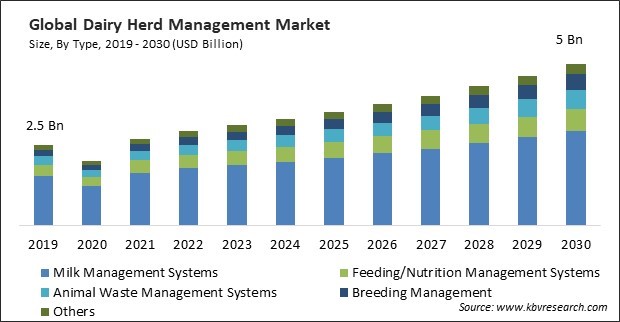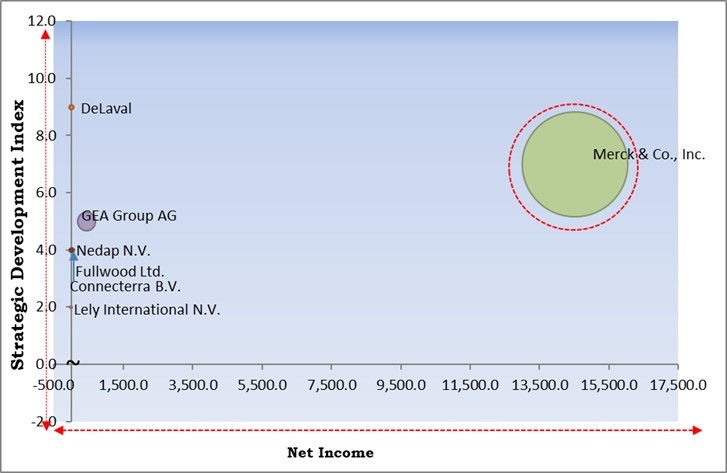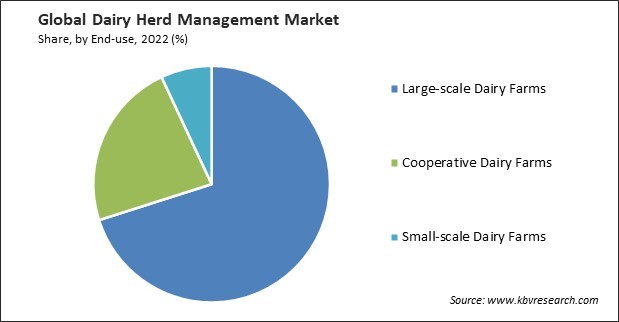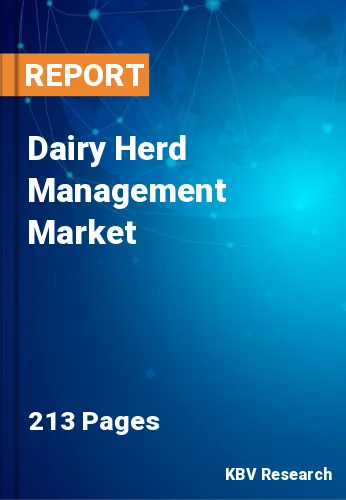The Global Dairy Herd Management Market size is expected to reach $5 billion by 2030, rising at a market growth of 7.1% CAGR during the forecast period.
Feeding/Nutrition Management Systems allows dairy farmers to choose the solution that best suits their operational needs, ultimately leading to healthier, more productive herds and improved farm profitability. Thus, the Feeding/Nutrition Management Systems segment captured $419.2 million revenue of the market in 2022. These systems are designed to optimize the well-being and productivity of dairy cattle by ensuring they receive the right balance of nutrients. In this market, several types of systems are prominent.

The major strategies followed by the market participants are Partnerships as the key developmental strategy to keep pace with the changing demands of end users. For instance, in October, 2023, Lely International N.V. partnered with Acorn Dairy Ltd. Through this alliance, the two companies are working together to offer an eco-friendly solution that reduces carbon dioxide emissions by 50%. Furthermore, in December, 2022, Connecterra B.V. entered partnership with ABS Global. Through this partnership, Connecterra aims to leverage ABS's digital solution, Ida, to enhance operational efficiency for dairy farmers and their advisors, ensuring smoother and more effective farming operations.
Based on the Analysis presented in the KBV Cardinal matrix; Merck & Co., Inc. is the forerunner in the Market. Companies such as GEA Group AG, Nedap N.V, are some of the key innovators in the Market. For instance, In August, 2023, GEA Group AG came into partnership with Unilever PLC, a renowned consumer goods enterprise. With this partnership, GEA will implement its cutting-edge manure enrichment solution, the ProManure E2950, in four dairy farms that provide milk to Unilever. Through this endeavor, they aim to leverage the system's data analysis capabilities to study its influence on eliminating Unilever's carbon footprint. This initiative is anticipated to make a substantial contribution to the reduction of greenhouse gas emissions across the entire milk production process.

Technological advancements have introduced precision livestock farming, a game-changing approach to dairy herd management. This technology leverages sensors and data analytics to monitor individual cows' health, behavior, and nutrition. The precision livestock farming system provides real-time data, allowing farmers to promptly identify and address health issues. As a result, the herd's overall health is improved, leading to increased milk production and reduced veterinary costs. Another positive impact of technological advancements in dairy herd management is the improved welfare of dairy cattle. Automation technologies, such as robotic milking machines, provide a stress-free and comfortable milking experience for cows. These advancements have introduced precision livestock farming, enabled data-driven decision-making, supported sustainability, improved animal welfare, and allowed for remote management, thereby propelling the growth of the market.
It plays a pivotal role in ensuring compliance with regulatory requirements in the dairy industry. Regulatory requirements often include specific guidelines related to animal welfare. Dairy herd management practices are designed to ensure dairy cattle's well-being and humane treatment. Additionally, Dairy herd managers are responsible for managing the reproductive cycle of dairy cattle, which often involves artificial insemination and pregnancy monitoring. These practices must align with regulations governing breeding and reproduction procedures to ensure animal welfare and reproductive health standards compliance. Thus, as it plays a central role in meeting regulatory requirements in the dairy industry, its increasing use is aiding in the growth of the market.
Larger, more technologically advanced dairy operations may readily embrace modern herd management practices and invest in advanced technologies. In contrast, smaller and traditional farms may be less inclined to adopt such systems due to financial constraints, lack of resources, or resistance to change. This fragmentation creates a disparity in the industry, hindering the widespread adoption of efficient herd management practices. Moreover, fragmented industry dynamics can hinder collaborative efforts to address common challenges. For example, collective initiatives to improve sustainability, animal welfare, or regulatory compliance may be less effective when farms have varying levels of commitment and resources. Thus, the fragmented nature of the dairy industry can negatively impact the market by creating disparities in the adoption of modern herd management practices, varying access to technology and resources, and inconsistencies in regulatory compliance.
On the basis of end-use, the market is classified into small-scale dairy farms, large-scale dairy farms, and cooperative dairy farms. The cooperative dairy farms segment recorded a significant revenue share in the market in 2022. Cooperative farms can pool data from various members and use herd management systems to analyze trends, share best practices, and collectively improve overall herd performance. A herd management system can help cooperative farms enforce uniform standards and best practices across member farms, improving overall quality and efficiency. By collectively managing and sharing information on disease outbreaks, supply chain disruptions, and market fluctuations, cooperative farms can better mitigate risks and plan for contingencies.

Based on type, the market is characterized into milk management systems, feeding/nutrition management systems, animal waste management systems, breeding management, and others. The animal waste management systems segment procured a considerable growth rate in the market in 2022. Proper waste management systems can significantly reduce the environmental pollution caused by animal waste, including contamination of water sources with nutrients and pathogens. Animal waste management systems allow for the precise application of nutrients to fields, reducing the risk of over-fertilization and nutrient runoff. Some waste management systems can generate biogas or electricity from animal waste, providing an additional source of income for farms.
| Report Attribute | Details |
|---|---|
| Market size value in 2022 | USD 2.9 Billion |
| Market size forecast in 2030 | USD 5 Billion |
| Base Year | 2022 |
| Historical Period | 2019 to 2021 |
| Forecast Period | 2023 to 2030 |
| Revenue Growth Rate | CAGR of 7.1% from 2023 to 2030 |
| Number of Pages | 213 |
| Number of Table | 283 |
| Report coverage | Market Trends, Revenue Estimation and Forecast, Segmentation Analysis, Regional and Country Breakdown, Competitive Landscape, Companies Strategic Developments, Company Profiling |
| Segments covered | Type, End-use, Region |
| Country scope | US, Canada, Mexico, Germany, UK, France, Russia, Spain, Italy, China, Japan, India, South Korea, Australia, Malaysia, Brazil, Argentina, UAE, Saudi Arabia, South Africa, Nigeria |
| Growth Drivers |
|
| Restraints |
|
Region-wise, the market is analyzed across North America, Europe, Asia Pacific, and LAMEA. The Europe segment witnessed the maximum revenue share in the market in 2022. European consumers and regulators are increasingly concerned about animal welfare. Dairy herd management systems can help improve animal health and well-being by monitoring and addressing issues promptly. Consumer demand for organic and ethically produced dairy products has grown in Europe. The region is home to research institutions and companies at the forefront of dairy technology. This environment fosters innovation and the development of advanced dairy herd management systems.
Free Valuable Insights: Global Dairy Herd Management Market size to reach USD 5 Billion by 2030
The market research report covers the analysis of key stake holders of the market. Key companies profiled in the report include Alta Genetics Inc. (Urus Group LP), DeLaval (Tetra Laval Group), GEA Group AG,Lely International N.V., Nedap N.V., Fullwood Ltd. (The Verder Group), SUM-IT Computer Systems Ltd, Connecteraa B.V and Merck & Co., Inc.
By Type
By End Use
By Geography
This Market size is expected to reach $5 billion by 2030.
Rapid technological advancements in dairy herd management are driving the Market in coming years, however, Low adoption because of the fragmented nature of the dairy industry restraints the growth of the Market.
Alta Genetics Inc. (Urus Group LP), DeLaval (Tetra Laval Group), GEA Group AG,Lely International N.V., Nedap N.V., Fullwood Ltd. (The Verder Group), SUM-IT Computer Systems Ltd, Connecteraa B.V and Merck & Co., Inc.
The expected CAGR of this Market is 7.1% from 2023 to 2030.
The Milk Management Systems segment led the Market, by Type in 2022; thereby, achieving a market value of $2.9 billion by 2030.
The Europe region dominated the Market, by Region in 2022, and would continue to be a dominant market till 2030; thereby, achieving a market value of $1.6 billion by 2030.
Our team of dedicated experts can provide you with attractive expansion opportunities for your business.

